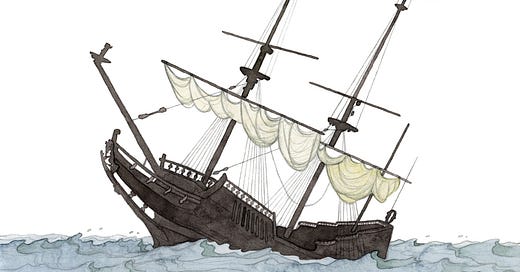Content warning: this story contains descriptions of colonial violence and sexual assault.
In 1629, the Dutch East India Company’s ship the Batavia wrecked on the Houtman Abrolhos Islands 65 km off the Western Australian coastline. Members of the ship’s crew mutinied, leading to a series of massacres involving the survivors. This was the first European shipwreck, first European massacre and first European colonial outpost in Australia.
On 28 October 1628, a fleet of seven cargo ships operating for the Vereenigde Oostindische Compagnie (Dutch East India Company) left Texel in Holland carrying a cargo of silver coins and antiquities bound for Batavia Java in the Dutch East Indies in present-day Jakarta, Indonesia.
In the North Sea off Europe, the fleet was caught in a severe storm, separating most of the ships. The Batavia managed to re-group with the two ships Assendelft and Buren.
The fleet of three then sailed to the Cape of Good Hope in South Africa, where they stopped before heading eastwards on the Roaring Forties in the Indian Ocean to Batavia Java. After leaving the Cape of Good Hope, the Batavia became separated from the Assendelft and Buren.
On the morning of 4 June 1629, the Batavia struck a coral reef on the Houtman Abrolhos Islands. The ship was officially carrying 341 people—approximately 180 sailors, 100 mercenaries and 60 civilian passengers—but the true figure is unknown.
The morning light revealed that 100 people had died from the collision. The survivors used the Batavia’s longboat to ferry 180 people to the adjoining Traitor and Beacon Islands 2km away. A small group remained on the wreck for nine days until it sank, then joined the other survivors on the islands.
In command of the Batavia was Francisco Pelsaert, Ariaen Jacobsz and Jeronimus Cornelisz. During the days following the wreck, they inspected the surrounding islands but could not find fresh water and food.
The two commanders, Pelsaert and Jacobsz, decided to sail the longboat to the mainland, along the coastline and then on to Batavia Java to seek help. They left in the middle of the night with 46 crew members, abandoning the remaining survivors on Traitor and Beacon Island.
The remaining 180 survivors formed a council, chaired by Jeronimus Cornelisz. Prior to the Batavia wrecking, Cornelisz had been plotting a mutiny in collaboration with the ship’s commander Ariaen Jacobsz to overthrow fleet commander Francisco Pelsaert. It had been their intention to steal the cargo and use the ship for piracy, but the shipwreck had thwarted their plans.
Jeronimus Cornelisz replaced the council members with his own men, the mutineers, and took control of the weapons and boats. He then split the population, sending them to perish on nearby Long and Seal Islands. His mutineers ferried 22 unarmed soldiers, under the command of Wiebbe Hayes, to West Wallabi Island to find water. His motive was to remove the threat posed by the soldiers and to take control of the remaining population on Beacon Island. However, Cornelisz was unaware that Hayes’ soldiers managed to find water on West Wallabi, as well as wallabies to eat.
Jeronimus Cornelisz and his mutineers now believed that they controlled the islands and the food supplies. In the weeks following, Cornelisz’ mutineers massacred all the survivors on Seal Island and then began slowly killing the remaining survivors on Beacon Island by cutting their throats or ferrying people out to sea and drowning them. Cornelisz’ motivation was to reduce the surviving population and ration the food supplies for his mutineers.The women were kept alive to be raped by Cornelisz and his mutineers.
In mid-July, Cornelisz ordered the massacre of the people on Long Island, but several survivors escaped and notified Wiebbe Hayes and his soldiers on West Wallabi of Cornelisz’s massacres.
In August Cornelisz and his men attempted three times to attack West Wallabi, but Hayes and his men defended the island. On the third attempt Cornelisz was captured and his three lieutenants were killed by Hayes’ men.
Wouter Looes took command of the mutineers and on 17 September attacked West Wallabi, killing three of Hayes’ men. Looes and the mutineers had nearly defeated Hayes when the rescuing ship Sardam was sighted on the horizon. Pelsaert had arranged the Sardam, sailing for seven weeks to rescue survivors on Abrolhos.
Pelsaert and Jacobsz, meanwhile, had been unable to find water on the Australian mainland and had sailed 33 days to Batavia Java, where Jacobsz was arrested for negligence in losing the Batavia.
On their arrival, Hayes informed Pelsaert of the mutineers’ massacres. Pelsaert arrested and jailed the mutineers, tortured them until they confessed, and hung Cornelisz and six mutineers. Looes and a cabin boy were marooned on the mainland. The 16 remaining mutineers and 70 survivors were taken to Batavia Java. It is estimated that Cornelisz and his mutineers had murdered 125 men, women and children.
Today, the remnants of Wiebbe Hayes’ stone fort is still on West Wallabi and is the Continent’s first and oldest European structure. There are an estimated 80 human remains from the massacres on Beacon Island.
The Batavia was salvaged in 1963 and is currently on display in the Western Australian Maritime Museum in Fremantle.
REFERENCES
https://www.sea.museum/2016/06/04/barbarism-and-brutality-surviving-the-batavia-shipwreck
https://www.awe.gov.au/parks-heritage/heritage/places/national/bataviahttps://
www.nma.gov.au/defining-moments/resources/wreck-of-the-batavia
https://www.ecoabrolhos.com.au/batavia-shipwreck/
https://www.visitgeraldton.com.au/play/the-batavia-story.aspx



